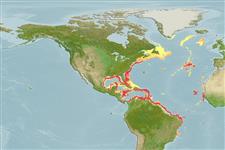>
Gadiformes (Cods) >
Macrouridae (Grenadiers or rattails)
Etymology: Coelorinchus: Greek, koilos = a hollow + Greek, rhyngchos = jaw (Ref. 45335).
More on author: Risso.
Issue
Eschmeyer and Bailey in Eschmeyer (1990:70) changed the spelling of the name from Coelorinchus coelorhincus (or Coelorhynchus coelorhynchus) to Caelorinchus caelorhincus, based on their interpretation of the name; caelo (an awl or engraving tool) made more sense than coelo (hollow). Iwamoto had followed their spelling since that time. However, Dr. Dirk Nolf (Institut royal des Sciences naturelles de Belgique) has informed him (in litt., 8 April 2003) that the name should be spelled with the dipthong oe based on the following logic: Giorna’s paper is in French, a language that does not have the dipthong 'ae'. Giorna (1810:179) writes: "Le Coelorinque-Coelorinchus, the first two words being French, the last Latin. The dipthong 'oe', logically must be the same in the two. Since the first name is in French, the second can only be spelled with an 'oe'. Nevertheless, revisiting the issue, Iwamoto, Eschmeyer and Fricke showed that the species should be written 'cae' (May 2008, email exhchanges).
Environment: milieu / climate zone / depth range / distribution range
Οικολογία
Θαλασσινό(ά) βενθοπελαγικό; μη μεταναστευτικό(ά); εύρος βάθους 90 - 1485 m (Ref. 104125), usually 200 - 500 m (Ref. 1371). Deep-water; 62°N - 18°S, 98°W - 17°W (Ref. 1371)
Northeast Atlantic and Mediterranean Sea. A loose sort of southern limit for Caelorinchus caelorhincus caelorhincus is probably around Cape Verde; most specimens south and to the east into the Gulf of Guinea are likely to be Caelorinchus caelorhincus geronimoi (Iwamoto 1997, pers. Comm.). Northwest Atlantic: Canada (Ref. 5951).
Μέγεθος / Βάρος / Age
Maturity: Lm ? range ? - ? cm
Max length : 48.0 cm TL αρσενικό/απροσδιόριστο; (Ref. 5951); common length : 30.0 cm TL αρσενικό/απροσδιόριστο; (Ref. 2683); μεγ. αναφερόμενη ηλικία: 10 έτη (Ref. 58045)
Ραχιαίες άκανθες (συνολικά) : 0; Εδρικές άκανθες: 0. Eyes large; snout short, moderately pointed, its anterolateral margin incompletely supported by bone. Head ridges strong but with rather fine spinules; terminal snout scute trifid, wider than long, small and blunt to large and pointed, with a terminal and two lateral arms of about equal size. Underside of the snout naked medially. Light organ large, a black naked fossa between and slightly anterior to the pelvic fin bases. Overall color is pale grayish-brown to swarthy, with a series of broad saddle marks in some; oral cavity pale to dark (Ref. 1371). Spiny fin ray of first dorsal fin with a smooth and rounded leading edge (Ref. 35388).
Found commonly in about 200-500 m. Feeds on a variety of benthic organisms, such as polychaetes, gastropods, cephalopods, numerous crustacean groups (copepods, gammarians, isopods, cumaceans, Natantia) and fish. Minimum depth range taken from Ref. 1371.
Life cycle and mating behavior
Maturities | Αναπαραγωγή | Spawnings | Egg(s) | Fecundities | Προνύμφες
Cohen, D.M., T. Inada, T. Iwamoto and N. Scialabba, 1990. FAO species catalogue. Vol. 10. Gadiform fishes of the world (Order Gadiformes). An annotated and illustrated catalogue of cods, hakes, grenadiers and other gadiform fishes known to date. FAO Fish. Synop. 125(10). Rome: FAO. 442 p. (Ref. 1371)
IUCN Red List Status (Ref. 130435)
Threat to humans
Harmless
Human uses
αλιεία: περιορισμένης εμπορικότητας
Εργαλεία
Special reports
Download XML
Διαδικτυακές πηγές
Estimates based on models
Preferred temperature (Ref.
123201): 8.6 - 19.6, mean 13.2 °C (based on 160 cells).
Phylogenetic diversity index (Ref.
82804): PD
50 = 0.5000 [Uniqueness, from 0.5 = low to 2.0 = high].
Bayesian length-weight: a=0.00191 (0.00158 - 0.00230), b=3.15 (3.10 - 3.20), in cm total length, based on LWR estimates for this species (Ref.
93245).
Τροφικό Επίπεδο (Ref.
69278): 3.5 ±0.2 se; based on diet studies.
Ελαστικότητα (Ref.
120179): Χαμηλό, ελάχιστος χρόνος για διπλασιασμό πληθυσμού 4,5 - 14 έτη (K=0.13-0.15; tmax=8).
Fishing Vulnerability (Ref.
59153): Moderate vulnerability (38 of 100).
Nutrients (Ref.
124155): Calcium = 16.7 [8.0, 38.2] mg/100g; Iron = 0.302 [0.148, 0.621] mg/100g; Protein = 15.4 [13.3, 17.9] %; Omega3 = 0.222 [0.093, 0.498] g/100g; Selenium = 25.6 [9.1, 65.5] μg/100g; VitaminA = 17.1 [3.3, 84.4] μg/100g; Zinc = 0.495 [0.309, 0.805] mg/100g (wet weight);
